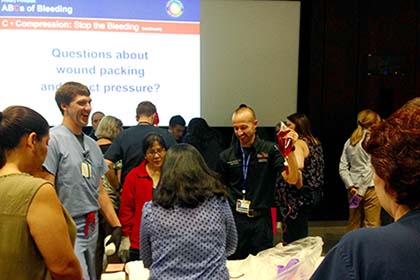National Stop the Bleed Day is March 31, schedule a class for your department today

National Stop the Bleed Day is March 31 and will be recognized throughout UT Southwestern during the first week in April. In the wake of mass shootings and violent acts across the U.S., the Medical Center supported the purchasing of equipment and training of our community. Stop the Bleed – or bleeding control training – is intended for both clinical and nonclinical personnel to understand techniques to prevent death from life-threatening bleeding. The skills taught in this course not only apply during catastrophic situations, but also during everyday incidents like motor vehicle accidents or injuries sustained in the kitchen or garage.
This nationwide campaign, created by the American College of Surgeons (ACS), will highlight the importance of Stop the Bleed training and will be provided to the campus on each day during the first week of April. You may sign up for open sessions through Taleo by searching “Stop the Bleed.” During the inaugural National Stop the Bleed Day in 2018, an estimated 16,000 registered instructors conducted more than 600 courses in the United States on or around March 31.
Both internally and within our community, UT Southwestern has trained over 3,500 people in the basic steps of bleeding control, including more than 220 Dallas ISD school nurses and two Medical School classes. Training is also included in the new student orientation schedule and was a popular topic at DocStars2018, an event for Southwestern Medical Foundation’s Cary Council.
How do you schedule a course at UTSW? Open enrollment courses were provided when Stop the Bleed was initially rolled out, but the initiative has seen greater success when provided at the department, clinic, or unit level. The course takes approximately one hour and is a combination of didactic lecture and hands-on training. If you are interested in scheduling this course, Email Stop the Bleed.
What other resources are available at UTSW? Numerous buildings on campus have a bleeding control kit. Many high-traffic areas, such as lobbies and cafeterias, have a dedicated large kit. Smaller kits are also available in many AED cabinets. For a detailed listing of Stop the Bleed kits by building and floor, visit the MyEOP mobile app.

